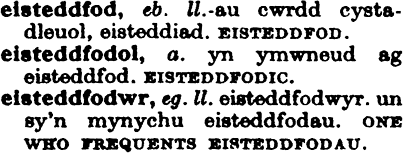
The Eisteddfod
© Christopher Davies (Publishers) Ltd.
Eisteddfod is one of the few Welsh words to have entered the English language – though English dictionaries disagree on exactly what it means – and it has been used all over the world to refer to a competitive cultural festival or celebration of the performing arts. Eisteddfod literally means a sitting (eistedd = to sit). Many people have heard of the International Eisteddfod, founded in 1947 with the aim of bringing people of all nations together in music, and held in Llangollen every July. And the Urdd Gobaith Cymru (so-called ‘Welsh League of Youth’) has its own Eisteddfod, held at the end of May in locations alternating between North and South Wales. But the mother of them all, sometimes referred to as the Prifwyl (‘chief festival’), is the Eisteddfod Genedlaethol Frenhinol Cymru, or Royal National Eisteddfod of Wales (the Frenhinol/Royal is less often used nowadays). Or ’Steddfod for short.
[PRONUNCIATION NOTE: Stress the penultimate syllable, and remember, the dd in eisteddfod represents a voiced dh as in this, not the voiceless th in think, while f in Welsh sounds like English v: eye-STEDH-vod.]
Explanations of the eisteddfodic terms used below can be found in this little glossary.
Some history
- The Eisteddfod’s an ancient tradition, isn’t it? Druids and all that?
Well, yes and no. The idea of a competitive gathering of musicians and poets is very old. The first recorded eisteddfod is thought to have taken place in Cardigan in 1176, though the word itself is not recorded until 1523, when the event became properly regulated as a sort of competitive test of professional aptitude for bards.
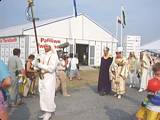
By the end of the 18th century the institution had started to fall into decline, but was revived in the early years of the 19th. In 1880 the National Eisteddfod Association was formed and since then the Eisteddfod has been held every year, except for 1914 and 1940. Just occasionally it has ventured outside Wales, the last time being in Liverpool in 1929 – though it seems there are moves afoot to persuade the Eisteddfod to pay another visit to Liverpool, where there is certainly a strong Welsh community.
Crucial in the establishment of the modern Eisteddfod was one Edward Williams (1747–1826), better known by his bardic name of Iolo Morgannwg (‘John of Glamorgan’).
It was he who instituted – in fact, invented – the link with the mysterious druids, through ancient texts he claimed to have found which detailed the ceremonies and dress of a British bardic court, or Gorsedd Beirdd Ynys Prydain [‘Court Of The Bards Of The Island Of Britain’]. Most of it was fantasy, but appealed to the mood of the times, and it caught on. He held the first Gorsedd on 21 June 1792 at Primrose Hill in london, in a ring of stones laid out on the grass. In 1819 the same ceremony was performed at an eisteddfod in Camarthen, and so it is that today grown men and women solemnly process onto stage in theatrical robes made of something looking like old bedsheets, resembling for all the world comedy ghosts or members of the Ku Klux Klan. (Those in green look as if they had stepped out of the operating theatre.)
Who were the druids anyway? No-one really knows, but we can feel fairly sure they didn’t dress up in colour-coded uniforms on a stage with a grand piano and cute flower-girls dancing around a horn of plenty. So the Eisteddfod in the form we know it today is basically a mixture of genuine cultural tradition and quaint Victorian whimsy.
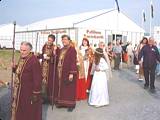
The Gorsedd
The bards come in three orders, distinguished by colour: blue, green and white. You can actually get into the lower orders by passing an exam, but only the ones in white are ‘real’ druids. They have either been winners themselves in the past, or been awarded a place in recognition of their services to the Welsh nation, and might be described as the heart of the Welsh literary and artistic establishment. And once a year, a photogenic tourist attraction.
It is the Gorsedd who preside over the main Eisteddfod ceremonies, and they certainly know how to put on a colourful show. The most famous and colourful events are the Coroni (crowning) and the Cadeirio (chairing). Both are prizes for poetry, the chair being awarded for a long poem in cynghanedd (‘strict metrical verse’, a demanding form involving complex patterns of alliteration and rhyme) and the crown for other verse-forms. Simultaneous translation into English via infra-red headsets is available for those who want it, and everything that happens in the pavilion is audible on loudspeakers outside the pavilion, as well as being broadcast on radio and TV.
In each case the ceremony begins with various formalities, such as welcoming delegates from the other Celtic nations, including representatives of the gorsedds of Cornwall and Brittany, before the adjudication is read out and the name of the winning bard announced. At this point he is identified only by his ffugenw or ‘bardic name’. In a moment of great theatricality, he is called upon to identify himself; spotlights pick him out where he stands and a delegation from the Gorsedd goes into the audience to greet him. They dress him in a velvet robe and escort him onto the stage, and only then is his real name revealed.
One of the most memorable chairings took place during the dark years of the First World War. In 1917, the Chair was won by the great Hedd Wyn (real name Ellis Humphrey Evans), whose story is told in the Oscar-nominated Welsh-language film Hedd Wyn. Having struggled against the odds to send in his entry while on active service on the Western Front, he was tragically killed just days before the ceremony. The Chair was awarded posthumously, draped in black.
The Eisteddfod today
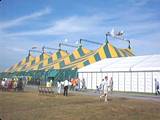
Today the Eisteddfod must be one of the biggest festivals in Europe. Alternating annually between venues in the North and South, it is always held in the first week of August, during which time a claimed 170,000 visitors pour through the turnstiles, contributing to an annual turnover of about £2.5 million. No fewer than 6,000 competitors vie for a range of prizes in music, poetry, dance and so on. There are many eisteddfodwyr (Eisteddfod-goers) who follow the festival around religiously from year to year, recognising friends they see only on the Eistedddfod field once a year, and many others who just drop in for a day out when it happens to fetch up in their area.
The Eisteddfod is simultaneously a vital focus for the Welsh-speaking community (and speakers of other Celtic languages too), a competitive arena for the performing arts, a feast for culture-vultures, a focus for campaigning, a boost for the tourist industry of the host area, a huge trade fair, a Welsh Woodstock or Glastonbury, and (weather permitting!) a fun day out. Since 1952, when the modern constitution was laid down, there has been a strict ‘Welsh-only’ rule: everything must happen in Welsh first and foremost, with or without an English translation.
The core of the modern Eisteddfod is the musical and poetic competitions, and in particular the big ceremonies of the Coroni (Crowning of the Bard) and the Cadeirio (Chairing of the Bard). Other major prizes include the Prose Medal, the Music Medal and the prize for the Welsh Learner of the Year, not to mention Cymru a’r Byd (‘Wales and the World’), a kind of gathering of the clans known until recently by the more picturesque title of Cymry ar Wasgar, ‘the Welshmen of the Diaspora’, hosted by Wales International, an organisation representing the expatriate Welsh. (I’m proud to say that once took part in this event as the representative of Belgium, where I was living at the time.)
But the Eisteddfod is much more than just picturesque ritual: away from the pavilion there’s a whole world of activity. It’s called maes yr Eisteddfod, the Eisteddfod field.
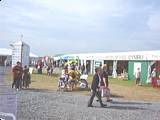
The Maes
All human life is there: universities, publishers, trade unions, political parties, quangos, pressure groups, charities, banks, radio and television stations, the Post Office, and of course dozens of shops and stalls, selling mostly books, music, food and crafts.
Major landmarks around the maes include Theatr y Maes [‘the theatre on the field’], used for music competitions and radio shows as well as plays, Pabell y Cymdeithasau [the societies tent], which provides a venue for meetings of all kinds, and Y Babell Lên [the literature tent]. The lively popular music tent, strategically placed on the extreme edge of the field, goes by a different name each year. Only songs in Welsh may be performed, which places limitations on certain major Welsh bands who start to write their hits in English when they get famous. Pabell y Dysgwyr [the learners’ tent] is a kind of drop-in centre for learners and teachers of Welsh, or indeed anyone in need of a cup of tea or shelter from the elements. It also offers Welsh lessons, competitions and and live events of various sorts, and you can watch the big ceremonies in the pavilion from there with extra commentary for learners.
The Eisteddfod is also a big event, culturally and financially, for the host area: it spills over into the surrounding towns in the form of evening events such as concerts and plays. Of course it’s a welcome boost for the local tourist trade. And the pubs for miles around are overflowing – there is no alcohol served on the maes.
A recent innovation is the Maes B, a music venue, a sort of alternative Maes next to the main one. It was hosted by Cymdeithas yr Iaith, the militant Welsh-language pressure group, until 2001 when they refused to give the Eisteddfod authorities a commitment not to stage any kind of demonstrations or direct action on the maes, something they often do. Instead Cymdeithas will be hosting a series of gigs in various venues away from the maes; I understand Maes B has been taken over by the Urdd (Welsh-language youth organisation). See the Eisteddfod site for details of what’s on.
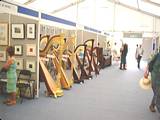
What to make of it all?
In Wales the Eisteddfod is big news. In the rest of the UK it’s usually treated as more of a ‘silly season’ story, yet more proof that the Welsh are basically mad, or at least foolish, histrionic and sentimental. The theatrical costumes and pseudo-ancient fol-de-rols are a gift to the sort of English mentality that despises any sort of extravagant behaviour and takes it for granted that foreigners have no sense of the ridiculous.
So, how should we regard this quaint ritual? Silly nonsense that gets the Welsh a bad name? Or a charming piece of romantic pageantry that provides a necessary visual focus to something as intangible as a poetry competition? I think it’s both. After all, you need ceremonies of some sort, and these ones have been around long enough to have acquired a sort of historical validity of their own. The English have their Beefeaters, and the Scots don’t feel embarrassed about the Edinburgh Military Tattoo. And of course, in the giant ‘heritage’ theme-park that is today’s Britain, they’re both good for business.
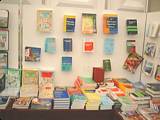
[FOOTNOTE for anyone mystified by these cultural references: the Beefeaters are the ceremonial guards at the Tower of London, with their picturesque scarlet uniforms, and the Tattoo is a military display at the Edinburgh Festival where soldiers in full Highland Dress perform sort of decorative marching routines. Pretty fanciful stuff in both cases.]
More importantly, in a country where Welsh achievement has not been rated highly at a national – i.e. British – level, the Gorsedd provides a useful Welsh equivalent of the (arguably corrupt) British honours system. For example the famous opera-singer Bryn Terfel, a first-language Welsh speaker but not a poet, was honoured with membership of the Gorsedd in recognition of his musical achievements. Any nation needs such institutions.
This year’s Eisteddfod
This year (2003) the Eisteddfod is in the North, or perhaps more accurately in mid-Wales: about 8 miles from Welshpool, near the village of Meifod. The official title is Maldwyn a’r Gororau (Montgomeryshire and the Marches). It runs from Saturday 2 to Saturday 9 August. The schedule of the main ceremonies will be something along these lines:
|
The Rhaglen Swyddogol (Official Programme) is the official guide to everything going on in the Eisteddfod, on and off the Maes. For details of how to get hold of a copy contact the Eisteddfod Office at the address below, or simply buy one when you get there.
Swyddfa’r Eisteddfod
Eisteddfod Genedlaethol Cymru
40 Parc Ty Glas
Llanisien
Cardiff
CF4 5WU
phone/fax: +44 (0)29 2076 3777
contact form: http://www.eisteddfod.org.uk/cymraeg/contacts.php
If you’re learning Welsh, and are going to be in or near Wales in August, you really should consider taking a trip to the Eisteddfod. For those who live outside Welsh-speaking Wales, it provides a uniquely concentrated dose of Welshness. You have all the Welsh institutions right there at your fingertips: where else could you find half a dozen specialist Welsh-language bookshops within five minutes of each other, not to mention shops selling Welsh music, videos, harps, objets d’art and tacky souvenirs of all sorts? And of course, it’s a fantastic opportunity to learn, practise and hear Welsh, and to meet up with other learners. You won’t be alone!
- FURTHER READING: Here’s where to find out more about the Eisteddfod.
- EISTEDDFOD GLOSSARY: some useful vocab relating to the Eisteddfod.
- EISTEDDFOD PHOTO ALBUM: some pictures from the Denbigh (Dinbych) eisteddfod of 2001 and the 2002 eisteddfod at Saint Davids (Tyddewi).
Diolch yn fawr i Stewart Russell am ei ffotos.
© 2000–2003 Harry Campbell (except photos)
Last updated: March 2003
